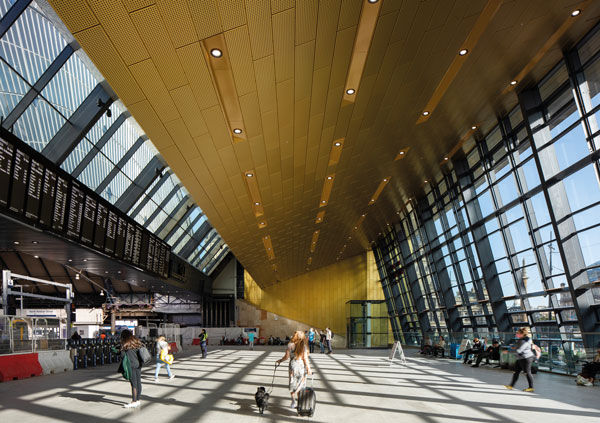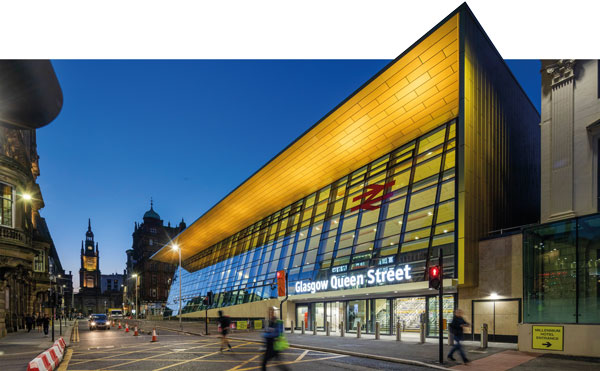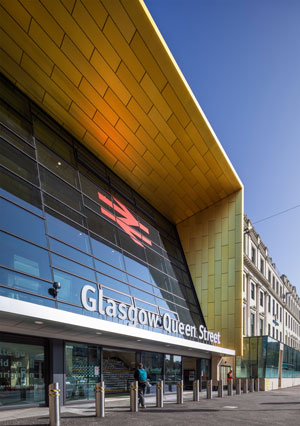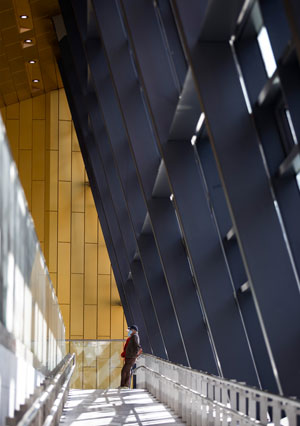SSDA Awards
AWARD: Glasgow Queen Street Station

A £120M redevelopment programme at Scotland’s third busiest railway station has provided extended platforms, an expanded concourse, and a contemporary interior and exterior.
FACT FILE
Architects: BDP & IDP
Structural engineer: Arup
Main contractor: Balfour Beatty
Client: Network Rail
Forming part of the Edinburgh Glasgow Improvement Programme (EGIP) – a Scottish Government investment in the railway infrastructure across central Scotland – the redevelopment of Glasgow Queen Street station has created a facility ready for a predicted growth in passenger numbers.
According to Network Rail, the number of people using the station is set to increase by 40 per cent, to reach 28M by 2030. To manage this growth, the redevelopment work has provided a spacious and accessible transport facility that has been carefully designed to be a positive and prominent addition to Glasgow’s historic George Square.
To manage this growth in passenger numbers, it was necessary to extend the existing platforms to accommodate longer trains and electrification of the lines as part of the wider EGIP scheme.
With little room for expansion to the north, which is restricted by the width of the tunnel entrance, it was necessary to extend the platforms into the existing station concourse to the south.
In order to make space for these platform extensions, as well as a new concourse and station entrances, Network Rail compulsorily purchased and subsequently demolished two buildings between the station and Glasgow’s George Square.

These two buildings – an eight-storey office block and an extension to the Millennium Hotel – both date back to the station’s previous modernisation programme that took place between 1969 and 1973.
The new station concourse is housed in a striking contemporary glass-fronted building, which wraps around the historic 1880s train shed and forms the centrepiece of the redevelopment.
Improving the passenger experience was a key focus of the design and the concourse is shaped to respond to pedestrian movement, while the dramatic roof structure floods the station with natural light and creates the desired city gateway.
The concept also creates new perspectives of the Category-A listed train shed, putting the Victorian structure at the heart of the design
The station remained open throughout the redevelopment works, and careful and complex phasing allowed construction to proceed, while minimising disruption to rail passengers.
A column-free concourse is created by a 54m-long × 4.5m-deep steel roof truss. Secondary trusses cantilever from this structural spine towards the train shed and the station frontage, which incorporates 15m-high RHS columns that restrain the curtain walled façade.
Weighing 80t, the roof truss was pre-cambered by over 60mm to remove dead load deflections, fabricated on the ground and lifted into place overnight by two 500t-capacity cranes. The roof has a triangular form and the sloping gold coloured aluminium soffit demands that the secondary trusses taper to create a thin leading edge where they meet the southern and western façades. Services, having risen through risers from basement level, are distributed from one part of the station to another through roof voids created by the trusses.
Arup Associate Structural Engineer Graeme Hanshaw says: “Steelwork allowed the long span structures to be prefabricated, reducing time and cost. The building could not have been built in the form that it has been without the use of structural steel.”
Office accommodation for the station staff occupies the upper levels of a new building on the west side of the development. This area is constructed over the top of the existing underground low-level station, which was created in the 1890s. An existing bridge structure could not sustain the loads from new columns, so a 38m span storey-high truss was constructed to support the new office block.
The truss is supported on pile caps, positioned behind an existing retaining wall for the low-level station. In order to protect passengers, this large steel element was lifted into position in sections, during an overnight operation.
The western side of the office block floorplate is supported on 1,050mm-deep plate girders, which span 22m over the low-level station. The suspended floors for the concourse and the upper levels are formed with metal decking and concrete slabs supported on steel beams to form a composite flooring solution.
For security reasons, the project’s cladding has been designed with blast resistance, while still maintaining a slender appearance with clean lines and careful detailing.
The judges say, providing a 90% increase in passenger capacity this major redevelopment above the low-level platforms was completed while the station remained fully functional. It has transformed a drab, unpopular station into one which restores the Victorian train shed and provides an impressive contemporary frontage onto Glasgow’s principal square. An exceptional achievement.











